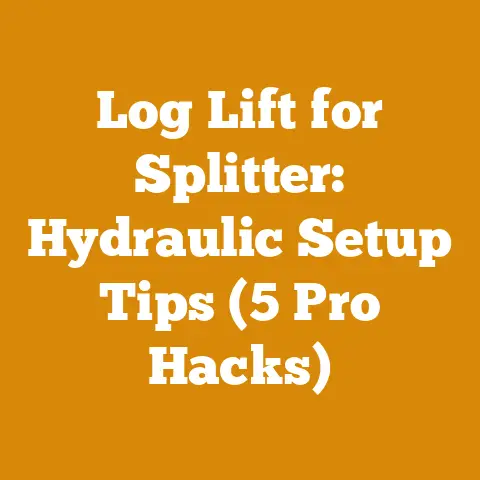How to Make a Fireplace More Efficient (5 Pro Wood Heat Hacks)
Blending Styles: Optimizing Fireplace Efficiency Through Wood Heat Hacks
As a seasoned woodsman and firewood enthusiast, I’ve spent years honing the craft of wood heating. I’ve learned that maximizing a fireplace’s efficiency isn’t just about throwing logs into the firebox; it’s a blend of understanding wood properties, mastering combustion techniques, and employing clever hacks to extract every bit of heat. Let’s embark on a journey to transform your fireplace from a charming ambiance enhancer into a powerful and efficient heat source.
Understanding Fireplace Inefficiency: Where Does the Heat Go?
Before diving into the hacks, it’s crucial to understand why fireplaces are often so inefficient. Traditional open fireplaces can lose up to 90% of their heat up the chimney. This happens because:
- Radiant Heat vs. Convection: Fireplaces primarily radiate heat, warming objects directly in front of them. They don’t efficiently circulate warm air throughout the room.
- Chimney Draft: The strong updraft needed to draw smoke up the chimney also pulls heated air out of the room.
- Incomplete Combustion: Inefficient burning releases unburnt hydrocarbons as smoke, wasting potential energy.
- Air Leaks: Poorly sealed dampers and fireplace structures allow cold air to infiltrate, further reducing efficiency.
Hack #1: Seasoned Firewood: The Cornerstone of Efficient Burning
The single most impactful factor in fireplace efficiency is the quality of your firewood. Seasoned wood, properly dried, burns hotter, cleaner, and longer.
Wood Moisture Content: A Critical Parameter
- Ideal Moisture Content: For optimal burning, firewood should have a moisture content between 15% and 20%.
- Green Wood Woes: Green wood (freshly cut) can have a moisture content of 50% or higher. Burning green wood wastes energy evaporating water, produces excessive smoke, and can lead to creosote buildup in the chimney, increasing the risk of chimney fires.
- Data Point: Studies show that burning wood with 40% moisture content reduces heat output by approximately 30% compared to wood at 20% moisture.
- Measurement Tools: A moisture meter is an essential tool for checking firewood. Insert the probes into a freshly split piece of wood to get an accurate reading. I personally use a Delmhorst BD-2100, known for its reliability.
- DIY Moisture Test: If you don’t have a moisture meter, you can perform a “soap bubble test.” Apply soapy water to the end of a split log. If air bubbles form quickly when you blow on the other end, the wood is likely dry enough. This is a rough estimate, but it’s better than nothing.
The Seasoning Process: Patience is Key
- Splitting Wood: Splitting wood increases the surface area exposed to air, accelerating the drying process. Aim for pieces that are roughly 6 inches in diameter.
- Stacking for Airflow: Stack wood off the ground on pallets or rails to allow air to circulate beneath the pile. Leave spaces between rows for cross-ventilation.
- Sun and Wind: Position your woodpile in a sunny, windy location for maximum drying potential.
- Covering the Top: Covering the top of the woodpile with a tarp or roofing material protects the wood from rain and snow, preventing it from reabsorbing moisture. Leave the sides open for ventilation.
- Drying Time: The drying time varies depending on the wood species, climate, and stacking method. Generally, hardwoods like oak and maple require at least 6-12 months to season properly. Softwoods like pine can dry faster, but they burn quickly and produce more creosote.
- Personal Experience: I once tried to rush the seasoning process by stacking wood too tightly. The result was moldy, slow-burning wood that barely produced any heat. Lesson learned: airflow is paramount!
Wood Species: Choosing the Right Fuel
- Hardwoods vs. Softwoods: Hardwoods (oak, maple, ash, beech) are denser than softwoods (pine, fir, spruce) and contain more energy per unit volume. They burn hotter and longer, making them ideal for sustained heat.
- BTU Content: BTU (British Thermal Unit) measures the heat content of fuel. Oak, for example, has a higher BTU rating than pine.
- Creosote Production: Softwoods tend to produce more creosote than hardwoods due to their higher resin content.
- Wood Density Chart:
| Wood Species | Approximate BTU/Cord | Creosote Production | Drying Time (Months) |
|---|---|---|---|
| Oak | 24-30 Million | Low | 12-24 |
| Maple | 20-25 Million | Low | 9-18 |
| Ash | 20-24 Million | Low | 6-12 |
| Beech | 22-27 Million | Low | 9-18 |
| Pine | 15-20 Million | High | 3-6 |
| Fir | 17-22 Million | Medium | 4-8 |
- Local Availability: Consider the availability of different wood species in your area. Sourcing locally reduces transportation costs and environmental impact.
- Mixing Wood Types: I often mix hardwoods and softwoods. I use softwoods to get the fire going quickly, then add hardwoods for sustained heat.
Hack #2: Fireplace Inserts: A Major Upgrade
Fireplace inserts are closed combustion chambers that fit inside your existing fireplace. They dramatically improve efficiency by:
- Controlled Airflow: Inserts regulate the amount of air entering the firebox, promoting more complete combustion.
- Heat Exchangers: Inserts often have built-in heat exchangers that capture and circulate heat into the room.
- Reduced Chimney Draft: Inserts minimize the amount of heated air escaping up the chimney.
- EPA Certification: Look for EPA-certified inserts, which meet stringent emissions standards and offer higher efficiency.
Types of Fireplace Inserts
- Wood-Burning Inserts: These are the most common type, burning seasoned firewood.
- Gas Inserts: Gas inserts offer convenience and ease of use, but they may not provide the same rustic charm as wood-burning inserts.
- Pellet Inserts: Pellet inserts burn compressed wood pellets, offering consistent heat and low emissions.
Installation Considerations
- Professional Installation: I highly recommend professional installation for fireplace inserts. Proper installation ensures safe and efficient operation.
- Chimney Liner: A stainless steel chimney liner is often required to protect the existing chimney from corrosion and creosote buildup.
- Clearances: Ensure that the insert is installed with proper clearances from combustible materials.
- Cost: Fireplace inserts can be a significant investment, but the increased efficiency and reduced heating costs can pay for themselves over time.
- Case Study: I helped a friend install a wood-burning insert in his drafty fireplace. Before the insert, he was burning through cords of wood with minimal heat output. After the installation, he reduced his wood consumption by over 50% and enjoyed a much warmer home.
Choosing the Right Insert: Key Specifications
- Heating Capacity: Choose an insert with a heating capacity that matches the size of your room or home. BTU ratings are a good indicator.
- Firebox Size: Consider the size of the firebox and the length of logs it can accommodate.
- Efficiency Rating: Look for inserts with high efficiency ratings (75% or higher).
- Emissions Rating: Choose an EPA-certified insert with low emissions.
- Features: Some inserts offer features like blowers, thermostats, and automatic air controls.
Hack #3: Top-Down Burning: Reversing the Fire
Traditional fire building involves placing kindling and small pieces of wood at the bottom, with larger logs on top. Top-down burning reverses this process, placing the largest logs at the bottom and kindling on top. This technique offers several advantages:
- Cleaner Burning: Top-down burning produces less smoke and creosote.
- Longer Burn Times: The fire burns slowly and steadily from top to bottom, extending burn times.
- More Efficient Combustion: The heat from the top layers ignites the gases released from the logs below, promoting more complete combustion.
How to Build a Top-Down Fire
- Base Layer: Place several large logs side by side at the bottom of the firebox.
- Middle Layer: Add a layer of smaller logs perpendicular to the base layer.
- Top Layer: Place kindling and tinder on top of the middle layer.
- Ignition: Light the kindling at the top.
- Airflow: Allow ample airflow initially to establish the fire.
Fine-Tuning the Technique
- Wood Size: Use a mix of log sizes, with the largest logs at the bottom.
- Airflow Control: Adjust the damper or air controls to regulate the burn rate.
- Experimentation: It may take some practice to perfect the top-down burning technique. Experiment with different wood configurations and airflow settings.
- Personal Anecdote: I was skeptical of top-down burning at first, but after trying it, I was amazed at how much cleaner and longer the fire burned. It’s now my go-to method for building fires.
Hack #4: Fireplace Draft Optimization: Controlling the Flow
Controlling the fireplace draft is crucial for efficient burning and preventing smoke from entering the room.
Damper Adjustment: Finding the Sweet Spot
- Fully Open vs. Partially Closed: A fully open damper allows maximum airflow, but it also pulls heated air out of the room. Partially closing the damper reduces airflow, but it can also cause smoke to back up into the room.
- Finding the Balance: The ideal damper setting is the lowest setting that allows smoke to escape up the chimney without billowing into the room.
- Factors Affecting Draft: The draft is affected by factors such as outside temperature, wind, and the height of the chimney.
- Chimney Height: A taller chimney generally creates a stronger draft. Building codes typically specify minimum chimney heights.
- Barometric Pressure: Low barometric pressure can reduce the draft, making it more difficult to start and maintain a fire.
- Seasonal Adjustments: You may need to adjust the damper setting depending on the season.
Chimney Cap Installation: Preventing Downdrafts
- Purpose: A chimney cap prevents rain, snow, and debris from entering the chimney. It also helps to prevent downdrafts, which can push smoke back into the room.
- Types of Chimney Caps: Chimney caps are available in various materials, including stainless steel, copper, and galvanized steel.
- Installation: Chimney cap installation is a relatively simple DIY project, but it’s important to choose the right size and type of cap for your chimney.
Sealing Air Leaks: Minimizing Heat Loss
- Common Leak Points: Air leaks can occur around the fireplace surround, the damper, and the chimney.
- Sealing Materials: Use caulk or weather stripping to seal air leaks.
- Benefits: Sealing air leaks reduces heat loss, improves fireplace efficiency, and prevents cold drafts.
- Professional Assessment: Consider hiring a professional to assess your fireplace for air leaks and recommend solutions.
Hack #5: Heat Distribution Techniques: Maximizing Warmth
Even with an efficient fireplace, the heat may not be evenly distributed throughout the room or home. These techniques help circulate the warm air and maximize its impact.
Fireplace Blower: Forced Air Circulation
- Purpose: A fireplace blower draws cool air from the room and circulates it around the firebox, then blows the heated air back into the room.
- Types of Blowers: Fireplace blowers are available as add-on accessories or built-in features of fireplace inserts.
- Benefits: Blowers significantly improve heat distribution and can warm a room much faster than a fireplace alone.
- Installation: Add-on blowers are relatively easy to install, while built-in blowers require professional installation.
- Noise Level: Consider the noise level of the blower when making your selection.
Room Fans: Creating Air Currents
- Strategic Placement: Place fans strategically in the room to create air currents that circulate warm air.
- Ceiling Fans: Run ceiling fans in reverse (clockwise) to push warm air down from the ceiling.
- Floor Fans: Place floor fans near the fireplace to circulate warm air away from the fireplace.
- Window Fans: Use window fans to exhaust cool air from other rooms, creating a vacuum that draws warm air from the fireplace room.
Ducting Systems: Extending the Heat
- Purpose: Ducting systems transfer heated air from the fireplace to other rooms in the home.
- Types of Ducting Systems: Ducting systems can be passive (relying on natural convection) or active (using a blower to force air through the ducts).
- Installation: Ducting systems require professional installation.
- Benefits: Ducting systems can heat multiple rooms with a single fireplace, reducing overall heating costs.
- Technical Considerations: Duct sizing, insulation, and airflow are critical factors in designing an effective ducting system.
Safety First: Essential Precautions for Wood Heating
Wood heating can be a safe and efficient way to heat your home, but it’s essential to follow safety precautions to prevent fires and carbon monoxide poisoning.
Carbon Monoxide Detectors: The Silent Killer
- Importance: Carbon monoxide (CO) is a colorless, odorless gas that can be deadly. CO detectors provide an early warning of CO buildup in your home.
- Placement: Install CO detectors on every level of your home, especially near sleeping areas.
- Maintenance: Test CO detectors regularly and replace the batteries every six months.
- Symptoms of CO Poisoning: Symptoms of CO poisoning include headache, dizziness, nausea, and confusion. If you suspect CO poisoning, evacuate your home immediately and call emergency services.
Chimney Inspections and Cleaning: Preventing Chimney Fires
- Creosote Buildup: Creosote is a flammable substance that builds up in chimneys as a result of incomplete combustion.
- Inspection Frequency: Have your chimney inspected annually by a qualified chimney sweep.
- Cleaning Frequency: Clean your chimney as needed, based on the amount of creosote buildup.
- DIY vs. Professional Cleaning: You can clean your chimney yourself with the right tools and knowledge, but professional cleaning is recommended for safety and thoroughness.
- Data Point: According to the National Fire Protection Association (NFPA), chimney fires are a leading cause of residential fires in the United States.
Fire Extinguishers: Ready for Action
- Type of Extinguisher: Keep a Class A fire extinguisher readily available near your fireplace.
- Proper Use: Learn how to use a fire extinguisher properly.
- Regular Inspection: Inspect your fire extinguisher regularly to ensure it is fully charged and in good working condition.
- Placement: Mount the fire extinguisher in a visible and accessible location.
Smoke Detectors: Early Warning System
- Importance: Smoke detectors provide an early warning of fire, giving you time to escape safely.
- Placement: Install smoke detectors on every level of your home, especially near sleeping areas.
- Maintenance: Test smoke detectors regularly and replace the batteries every six months.
- Interconnected Detectors: Consider installing interconnected smoke detectors, which all sound an alarm when one detector is triggered.
Safe Ash Disposal: Preventing Accidental Fires
- Metal Container: Store ashes in a metal container with a tight-fitting lid.
- Placement: Place the container away from combustible materials.
- Cooling Period: Allow ashes to cool completely before disposing of them. This can take several days.
- Disposal Method: Dispose of ashes in a non-combustible location, such as a gravel driveway or garden.
- Avoid Composting: Do not compost ashes, as they can contain embers that can reignite.
Tool Calibration Standards: Chainsaw Maintenance for Efficient Wood Processing
A well-maintained chainsaw is essential for efficient and safe wood processing. Proper calibration ensures optimal performance and extends the life of your saw.
Chain Sharpening: Maintaining Cutting Efficiency
- Importance: A sharp chain cuts faster, smoother, and with less effort. A dull chain can be dangerous, as it can cause the saw to kickback.
- Sharpening Frequency: Sharpen your chain regularly, depending on the type of wood you are cutting and the amount of use.
- Sharpening Tools: Use a chainsaw file, a sharpening jig, or a chainsaw sharpener to sharpen your chain.
- File Angle and Depth: Maintain the correct file angle and depth when sharpening your chain. Refer to your chainsaw’s manual for specific instructions.
- Depth Gauge Adjustment: Check and adjust the depth gauges on your chain to ensure proper cutting depth.
- Personal Experience: I once tried to cut down a tree with a dull chain. It took forever, and the saw kept kicking back. I learned my lesson: a sharp chain is essential!
Carburetor Adjustment: Optimizing Fuel Mixture
- Purpose: The carburetor regulates the air-fuel mixture in the engine. Proper carburetor adjustment ensures optimal performance and fuel efficiency.
- Adjustment Screws: The carburetor has three adjustment screws: the low-speed screw (L), the high-speed screw (H), and the idle speed screw (T).
- Adjustment Procedure: Refer to your chainsaw’s manual for specific carburetor adjustment instructions.
- Lean vs. Rich Mixture: A lean mixture has too much air and not enough fuel, while a rich mixture has too much fuel and not enough air.
- Symptoms of a Lean Mixture: A lean mixture can cause the engine to overheat and damage internal components.
- Symptoms of a Rich Mixture: A rich mixture can cause the engine to run poorly and produce excessive smoke.
- Professional Adjustment: If you are not comfortable adjusting the carburetor yourself, take your chainsaw to a qualified service technician.
Bar and Chain Lubrication: Reducing Friction and Wear
- Importance: Proper bar and chain lubrication reduces friction and wear, extending the life of the bar and chain.
- Oil Type: Use a high-quality bar and chain oil.
- Oil Level: Check the oil level regularly and refill as needed.
- Oil Pump Function: Ensure that the oil pump is functioning properly.
- Cleaning: Clean the bar and chain regularly to remove dirt and debris.
- Bar Maintenance: Check the bar for wear and damage, and replace it as needed.
Spark Plug Inspection and Replacement: Ensuring Reliable Ignition
- Importance: The spark plug ignites the air-fuel mixture in the engine. A clean and properly functioning spark plug ensures reliable ignition.
- Inspection Frequency: Inspect the spark plug regularly for wear and damage.
- Cleaning: Clean the spark plug with a wire brush.
- Gap Adjustment: Check and adjust the spark plug gap to the specified setting.
- Replacement: Replace the spark plug as needed.
- Spark Plug Type: Use the correct type of spark plug for your chainsaw.
Wood Selection Criteria: Matching Wood to Purpose
Different wood types excel in different applications. Understanding their properties helps optimize your wood usage.
Firewood Selection: Heat Output and Burn Time
- Density and BTU: As mentioned earlier, hardwoods are denser and have higher BTU content, resulting in longer burn times and greater heat output.
- Ease of Splitting: Some hardwoods, like ash, are easier to split than others, like elm.
- Smoke Production: Consider the smoke production of different wood species, especially if you have neighbors nearby.
- Availability and Cost: Balance your wood selection based on availability and cost.
Construction Lumber: Strength and Durability
- Species: Softwoods like pine and fir are commonly used for framing, while hardwoods like oak and maple are used for flooring and furniture.
- Grading: Lumber is graded based on its strength and appearance.
- Moisture Content: Construction lumber should be properly dried to prevent warping and shrinking.
- Treatment: Lumber may be treated with preservatives to protect it from insects and decay.
Craft Wood: Aesthetics and Workability
- Grain Pattern: Consider the grain pattern of the wood when selecting wood for crafts.
- Color: Choose wood with a color that complements your project.
- Workability: Some woods are easier to carve, turn, or bend than others.
- Stability: Select wood that is stable and resistant to warping and cracking.
Conclusion: Mastering the Art of Wood Heat
Optimizing your fireplace efficiency is a journey that combines knowledge, technique, and a little bit of experimentation. By focusing on seasoned firewood, considering fireplace inserts, mastering top-down burning, optimizing draft, and distributing heat effectively, you can transform your fireplace into a powerful and efficient heat source. Remember to prioritize safety and maintain your equipment for years of warm and enjoyable fires. And most importantly, enjoy the process! There’s something deeply satisfying about providing warmth and comfort with the fruits of your own labor.






